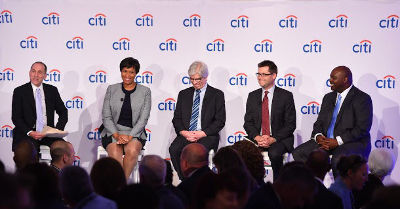Three Things Cities Should Do To Be Competitive
This post is adapted from Ed Skyler's remarks at the New York Times 'Cities for Tomorrow' conference in New York on July 21, 2015.

Image credit: Larry Busacca/Getty Images for The New York Times
Citi has a unique interest in cities. Cities aren't just in our name – they have been in our DNA since we opened our doors in Lower Manhattan over 200 years ago.
Massive population and economic shifts are impacting cities. 100 million people are moving to cities every year and nearly 70% of the world's population is expected to be urban by 2050. The top 100 cities in the world will generate 35% of global economic growth over the next 10 years.
But when we talk about economic growth, we have to acknowledge that it won't automatically be spread evenly across cities like peanut butter. It's a competition and those cities that positon themselves for growth will emerge the strongest.
We looked at this in a study we conducted with The Economist. There are key factors that make a city competitive, such as the strength of its government institutions, infrastructure, financial maturity, human capital and cultural institutions.
Based on my experience in New York City government and now in the private sector, I think there are three key things cities should do to be more competitive.
 Image credit: Larry Busacca/Getty Images for The New York Times
Image credit: Larry Busacca/Getty Images for The New York Times
First, cities are part of a network and they should share good ideas. Actually, they should not be afraid to steal good ideas.
Despite how much credit my former boss Michael Bloomberg has been given for several legacy initiatives, each of them started first in other cities.
In 2003, Mayor Bloomberg signed a law that banned smoking in bars and restaurants in New York City. After strong opposition, the smoking ban is now celebrated as a public health success and today, 500 cities around the world have enacted similar policies. But the first city in the United States to ban smoking in restaurants wasn't New York, it was Aspen, Colorado, back in 1985.
The first bike share program in the world started 50 years ago in Amsterdam. Citi Bike launched in New York two years ago and bike shares continue to gain popular support in cities around the world.
Second, cities need to embrace risk-taking in order to innovate.
Here is where the private sector can contribute. Public-private partnerships have accomplished many great things, but to me, the real value of private sector involvement is not measured in the amount of dollars. It's about having the flexibility and freedom to try new ideas.
In the private sector, risk-taking and innovation is expected by the public. But government is rarely a leader when it comes to experimentation and trying new ideas. The scrutiny on tax dollars makes governments reluctant to take risks. But that doesn't mean this is how it has to be. Risk-taking by cities needs to be catalyzed, not constrained.
Bike sharing is a perfect example of this. The Bloomberg administration didn't want public money to pay for a bike share program because it was too controversial. Without resources from the private sector – in this case structured through a sponsorship with Citigroup – the system would not have happened. Two years later, it's the largest bike share program in the country and in just two years, it has generated almost 20 million trips.
Third, there's a huge demand for infrastructure in the world's cities. The need has been estimated at $57 trillion dollars over the next 15 years.
Here the private sector – more specifically, the financial sector – is critical to accessing the capital markets to make these projects happen.
At Citi, we're proud to have many city governments as clients and to work on important projects in cities.
We're part of the consortium that will renovate the Central Terminal at La Guardia airport. We partnered with others to turn the streetlights back on in Detroit, which is improving safety and the quality of life.
We also help cities become more sustainable.
In February, we announced a 10-year commitment to lend, invest and facilitate $100 billion dollars to finance sustainable growth and reduce the impacts of climate change.
We raised the financing for Central America's first commuter rail system – the Panama Metro – which is easing traffic congestion by transporting 30,000 commuters per hour in that fast-growing city.
In the U.S., aside from being the leading lender for affordable housing, we're helping households become more energy efficient by providing low-cost loans for energy improvements such as installing more efficient boilers and smart thermostats.
We're very proud of the various ways in which we support the growth of cities. Our 'Citi for Cities' initiative draws on all of the resources of our company to provide solutions that help cities to solve their problems – and thrive.
The examples I've shared aren't philanthropy. They're part of our business model. It's what we do as a global bank.
But obviously we can't solve these difficult urban challenges alone. By collaborating across sectors, we can help cities manage the challenges presented by unprecedented growth in cities and improve the lives of their citizens.
 Image credit: Larry Busacca/Getty Images for The New York Times
Image credit: Larry Busacca/Getty Images for The New York Times
At the conference, Citi convened a panel to discuss how leaders from across the urban ecosystem have invested, partnered, and acted to positively impact citizens and their communities.
(Left to right: Ben Hecht, President and C.E.O., Living Cities - moderator, Muriel Bowser, Mayor, Washington, D.C., Paul Romer, Director, Marron Institute of Urban Management, Cisco DeVries, C.E.O., Renew Financial, Odis Jones, C.E.O., Public Lighting Authority of Detroit)